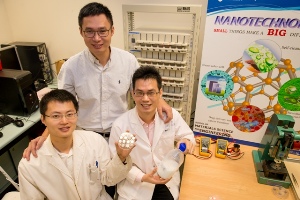By Stuart Milne
Nanyang Technology University (NTU) scientists have developed the next generation of batteries that have a 20-year lifespan and last for 10,000 recharge cycles. These batteries can be rapidly recharged up to 70% of their capacity within a short duration of two minutes.
 (Clockwise from top) NTU Assoc Prof Chen Xiaodong with research fellow Tang Yuxin and PhD student Deng Jiyang
(Clockwise from top) NTU Assoc Prof Chen Xiaodong with research fellow Tang Yuxin and PhD student Deng Jiyang
This new development is applicable to electric vehicles, mobile phones, tablets and cameras where rechargeable lithium-ion batteries are used.
Typical lithium-ion batteries have a lifespan of 500-cycles and take up to two hours for reaching full charge.
The battery anode is made from graphite, and additives are used for binding the electrodes to the graphite anode. The transfer speed of ions and electrons in and out of the batteries is affected. The binding also affects the amount of energy that can be packed within a certain space.
Scientists at NTU have developed a new gel material from titanium dioxide and have used it in place of the graphite anode in the battery. Titanium dioxide is a safe, low-cost material that is widely available. It has as spherical shape and the researchers have transformed this shape into the form of tiny nanotubes. This unique form enables superfast charging, as it increases the speed of chemical reactions within the battery.
The nanotube gel can be easily manufactured by mixing titanium dioxide with sodium hydroxide at a specific temperature. This process can be easily adopted in present-day battery manufacturing processes. Furthermore, the new battery does not require additives for binding electrodes to the anode, as their electrodes are based on cross-linked titanium dioxide nanotubes. This also enables more energy to be packed within a certain space.
The researchers plan to build a large prototype of the battery by seeking a proof-of-concept grant. They anticipate commercialization of the technology within two years, as a company has already licensed this novel technology.
This new battery technology will enable electric cars to get charged within five minutes and increase widespread usage of these cars, benefiting the environment. And, as these batteries have a longer life, the toxic waste due to disposal of batteries is also reduced.
This study has been published in the international materials science journal, Advanced Materials.
References